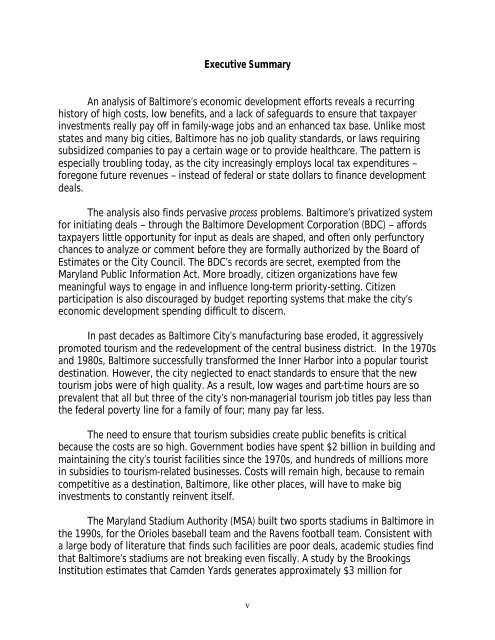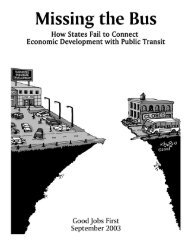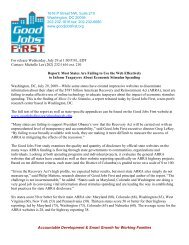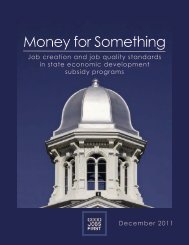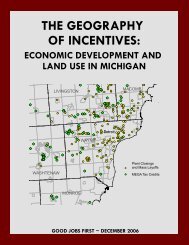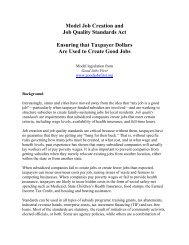Subsidizing the Low Road: Economic ... - Good Jobs First
Subsidizing the Low Road: Economic ... - Good Jobs First
Subsidizing the Low Road: Economic ... - Good Jobs First
You also want an ePaper? Increase the reach of your titles
YUMPU automatically turns print PDFs into web optimized ePapers that Google loves.
Executive SummaryAn analysis of Baltimore’s economic development efforts reveals a recurringhistory of high costs, low benefits, and a lack of safeguards to ensure that taxpayerinvestments really pay off in family-wage jobs and an enhanced tax base. Unlike moststates and many big cities, Baltimore has no job quality standards, or laws requiringsubsidized companies to pay a certain wage or to provide healthcare. The pattern isespecially troubling today, as <strong>the</strong> city increasingly employs local tax expenditures –foregone future revenues – instead of federal or state dollars to finance developmentdeals.The analysis also finds pervasive process problems. Baltimore’s privatized systemfor initiating deals – through <strong>the</strong> Baltimore Development Corporation (BDC) – affordstaxpayers little opportunity for input as deals are shaped, and often only perfunctorychances to analyze or comment before <strong>the</strong>y are formally authorized by <strong>the</strong> Board ofEstimates or <strong>the</strong> City Council. The BDC’s records are secret, exempted from <strong>the</strong>Maryland Public Information Act. More broadly, citizen organizations have fewmeaningful ways to engage in and influence long-term priority-setting. Citizenparticipation is also discouraged by budget reporting systems that make <strong>the</strong> city’seconomic development spending difficult to discern.In past decades as Baltimore City’s manufacturing base eroded, it aggressivelypromoted tourism and <strong>the</strong> redevelopment of <strong>the</strong> central business district. In <strong>the</strong> 1970sand 1980s, Baltimore successfully transformed <strong>the</strong> Inner Harbor into a popular touristdestination. However, <strong>the</strong> city neglected to enact standards to ensure that <strong>the</strong> newtourism jobs were of high quality. As a result, low wages and part-time hours are soprevalent that all but three of <strong>the</strong> city’s non-managerial tourism job titles pay less than<strong>the</strong> federal poverty line for a family of four; many pay far less.The need to ensure that tourism subsidies create public benefits is criticalbecause <strong>the</strong> costs are so high. Government bodies have spent $2 billion in building andmaintaining <strong>the</strong> city’s tourist facilities since <strong>the</strong> 1970s, and hundreds of millions morein subsidies to tourism-related businesses. Costs will remain high, because to remaincompetitive as a destination, Baltimore, like o<strong>the</strong>r places, will have to make biginvestments to constantly reinvent itself.The Maryland Stadium Authority (MSA) built two sports stadiums in Baltimore in<strong>the</strong> 1990s, for <strong>the</strong> Orioles baseball team and <strong>the</strong> Ravens football team. Consistent witha large body of literature that finds such facilities are poor deals, academic studies findthat Baltimore’s stadiums are not breaking even fiscally. A study by <strong>the</strong> BrookingsInstitution estimates that Camden Yards generates approximately $3 million forv


